Note: This page contains the transcribed, annotated notes from Volume I of the 1979 Sant’Angelo Vecchio Field Notebooks. The notes have been divided and annotated by area. Annotations, by Francesca Silvestrelli, appear in italics.
Sant’Angelo Vecchio 1979, Notebook Volume I
Mary E. Emerson, Site Supervisor
Squares E-1 to E-3
Si spostano a pulire la zona subito a S del muro 106, dove in pianta è segnata una concentrazione di laterizi (US 119) che è probabilmente lo stesso crollo di US 112. Il crollo non sembra venire scavato, ma solo pulito e rilevato. La pulizia restituisce GW.
July 2, 1979
E-1, South of Sounding A, surface cleaning (=US 119; p. 100)
This a roughly triangular piece of the slope W of the modern slope and included within square E-2. The exact limits of E-2 however have not been set precisely at this time. This area is just south of Sounding A, and seems to have the same kind of tile fall/concentration as we found just West of the wall (US 112).
Pottery: 6 coarseware sherds, including one thick round handle (SA 79 735PL)
Aprono quindi un saggio in corrispondenza della metà N della courtyard dove a giugno hanno fatto il Sounding A. La documentazione non è precisa perché non sono segnate battute e livelli, che si ricavano dal materiale. Fanno due battute che attribuiscono al Level 1 e una al Level 2, per poi fermarsi perché emerge il setto murario S della piccola fornace (US 121). Che è quindi coperta dal crollo. Il materiale di queste battute è scarso, nel senso che asportano un centinaio di frammenti di laterizi ma solo pochi vengono tenuti. Una porzione di 112 è dunque ancora in posto.
E-2, Sounding A-1 (=US 120, 112: L’uguaglianza non è perfetta, perché ci sono le due battute ma non sono descritte; p. 99)
This morning we begin another cut in the area of Sounding A, which will be called A-1 (see sketch below). For the purpose of water separation.
Soil samples: SA 79 552SS?; SA 79 571SS?; SA 79 585 SS
As in Sounding A, many tiles were removed, ca. 75–100, from this meter strip alone. About 20% of them are thick pan-tile fragments. Saved: very flat frag, one narrow cover, SA 79 753T
Pottery: ca. 25 sherds, many joins, mostly medium size coarseware SA 79 798PL (dal database risulta con questo numero solo un frammento di tegola).
Iron frag: 11 cm long (a squarish nail?), SA 79 706M
There appears to be a rock and tile feature, which is straight enough to be a wall along the north edge of the Sounding.
SA 79 754T (A, B); SA 79 766T?; SA 79 843T?; SA 79 933P (A-C)?; SA 79 984P
[Later in the day this was obviously part of the kiln so the Sounding here will be discontinued].
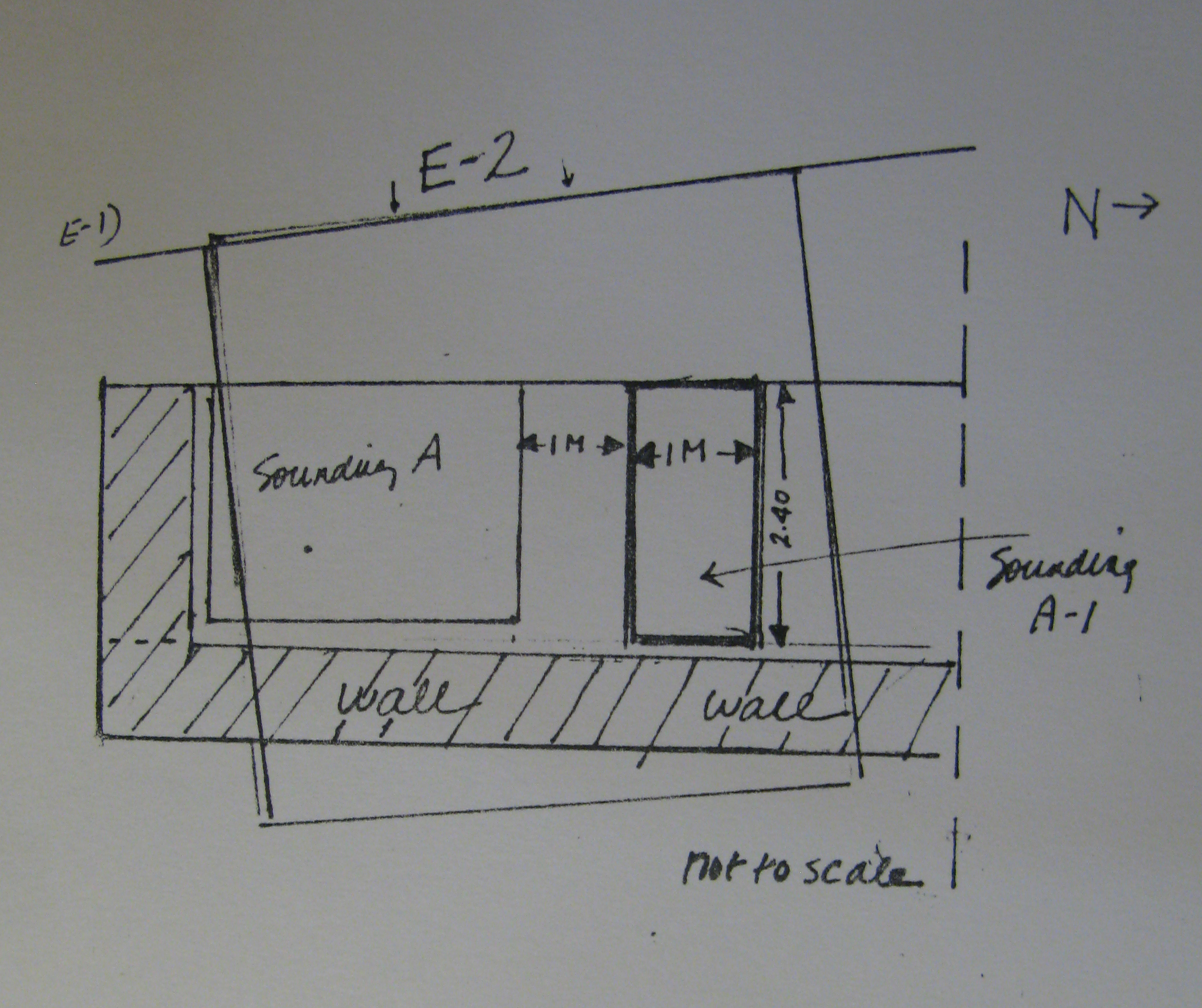
È possibile che i materiali indicati come Sounding A-1 Level 2 Batt 1 (US 120) siano in realtà in parte dal livello che segue. Appurato che erano di fronte ad una fornace infatti abbandonano il sondaggio e ampliano lo scavo verso N. Ne consegue che E-3 L2 B1 e 2 costituiscono l’asportazione del terreno che copre la piccola fornace. Non vi è sempre indicazione della provenienza dei pezzi, se all’interno o immediatamente all’esterno. Gli do quindi un solo numero distinguendo tra 123a (tutto intorno)e b (all’interno della piccola fornace). Non fanno altre foto, le faranno solo alla fine, quando la fornace è stata finita di scavare.
E-3, Level 2, Batt. 1, between Soundings B and A (=US 123a; p. 101)
A stone wall appeared as was expected, aligning at right angles to the corner of wall next to the road but was wider (60 cm) and did not contain tiles. It is also higher due in part to the natural slope. The area contained some large TC bricks and 2 green TC blob frags in addition to 50–75 tiles.
Finds: Frag. of tile with cartwheel stamp (SA 79 774T [=SAV RT 137, inserito quindi in pubblicazione]; SA 79 772PL); two rectangular tiles for pavement? H 9 cm, width 4.5 cm th 2 cm (SA 79 775T); pottery—5 coarseware sherds (SA 79 772PL) and 2 fine ware (si tratta di vernice nera, due pareti non datate) that were found in the water separation.
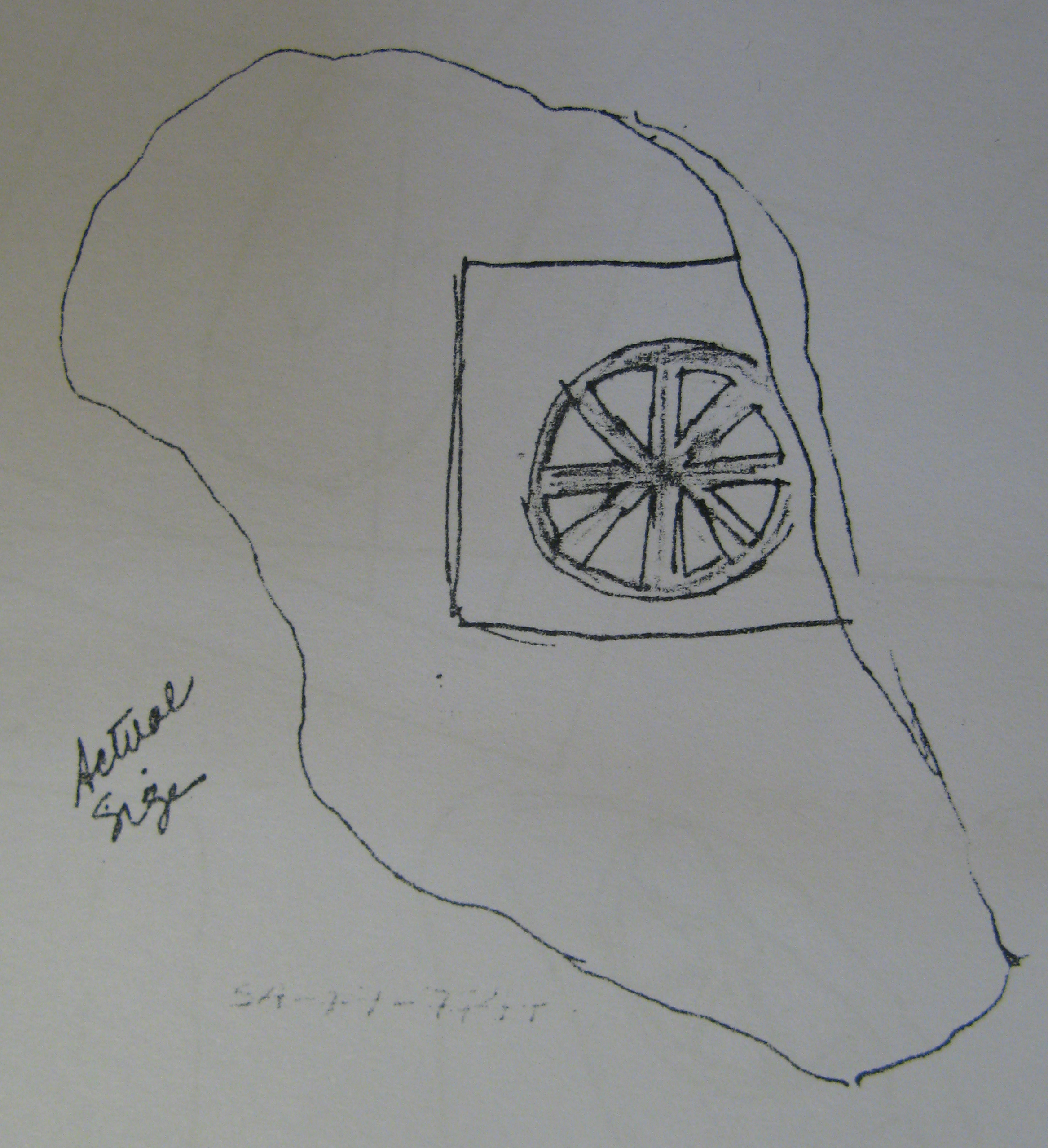
At the end of the day it became more and more apparent that there was a kiln here. Beginning just south of the 60 cm wide newly found wall and including the rocks and tile feature discovered in Sounding A-1, which will be discontinued for obvious reasons. The water separation was completed however with all the soil that actually was removed.
July 3, 1979
E-2/E-3, Level 2, Batt. 2, continued, cleaning (little kiln=US 123b; p. 102)
Area of the kiln
This morning we finished cleaning and defining the kiln area (see sketch below) and photos were taken.
Finds: frag. of tile with frag. of cartwheel stamp (SA 79 770T), found between kiln and wall parallel to road; coarseware handle frag.; pottery—3 fine coarseware sherds, also 2 BG (SA 79 768 PL)

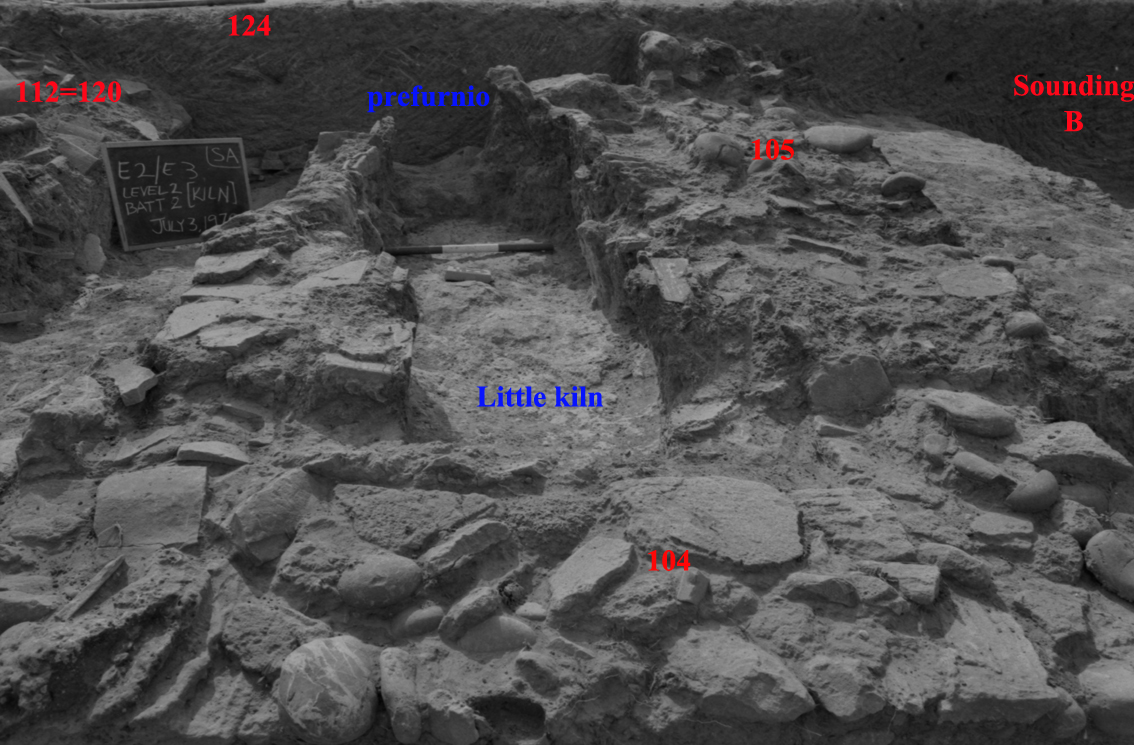
A selection of mudbricks and tile frags from this area were sent to Pizzica for later chemical and botanical analysis, uncatalogued. Note: nothing of any significance was found within the kiln.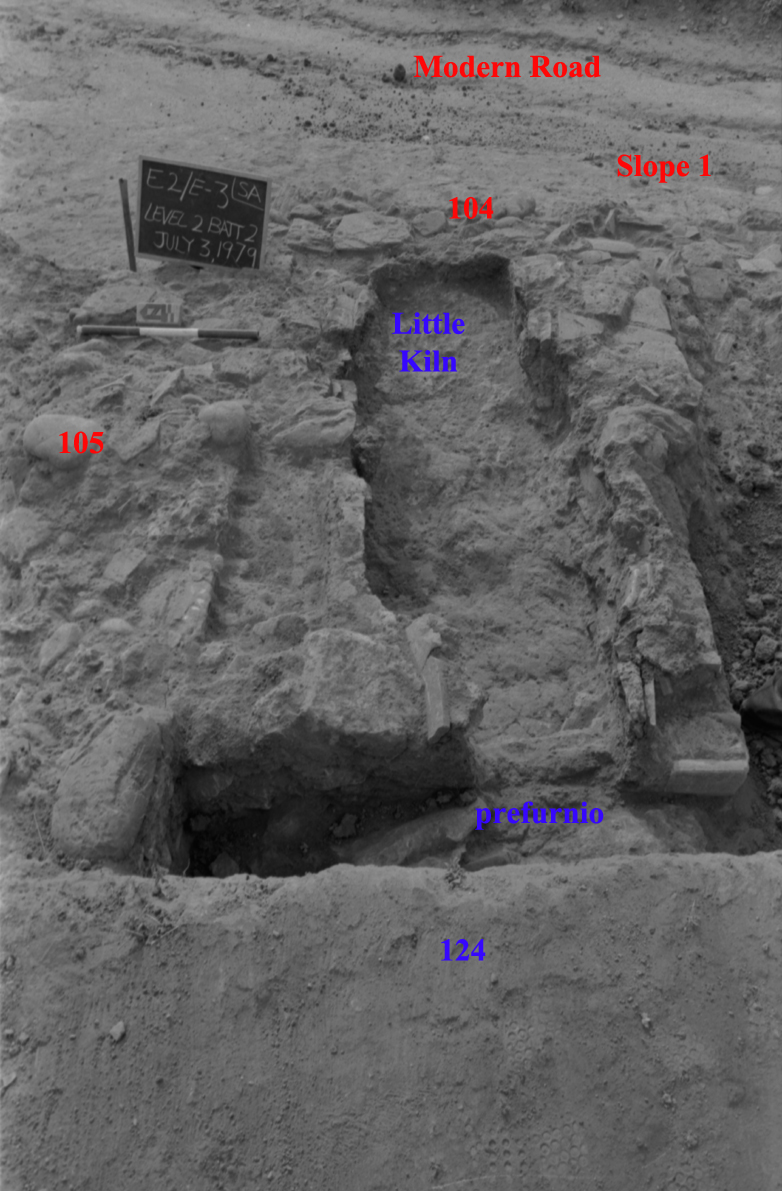
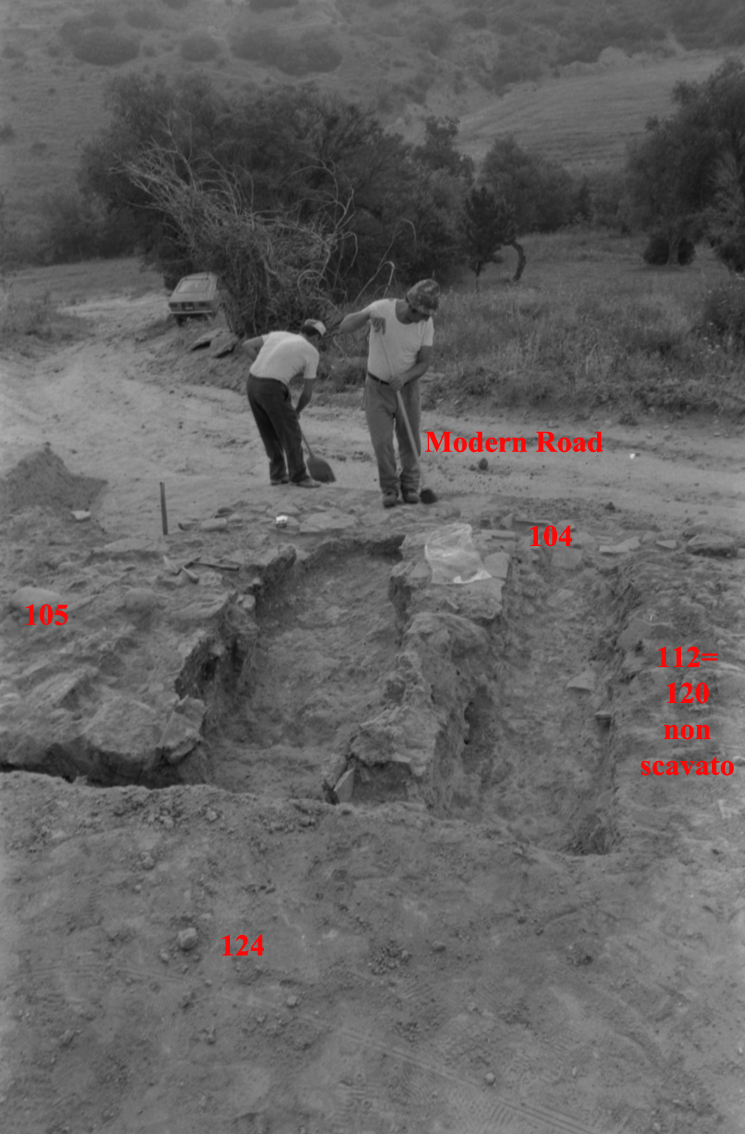

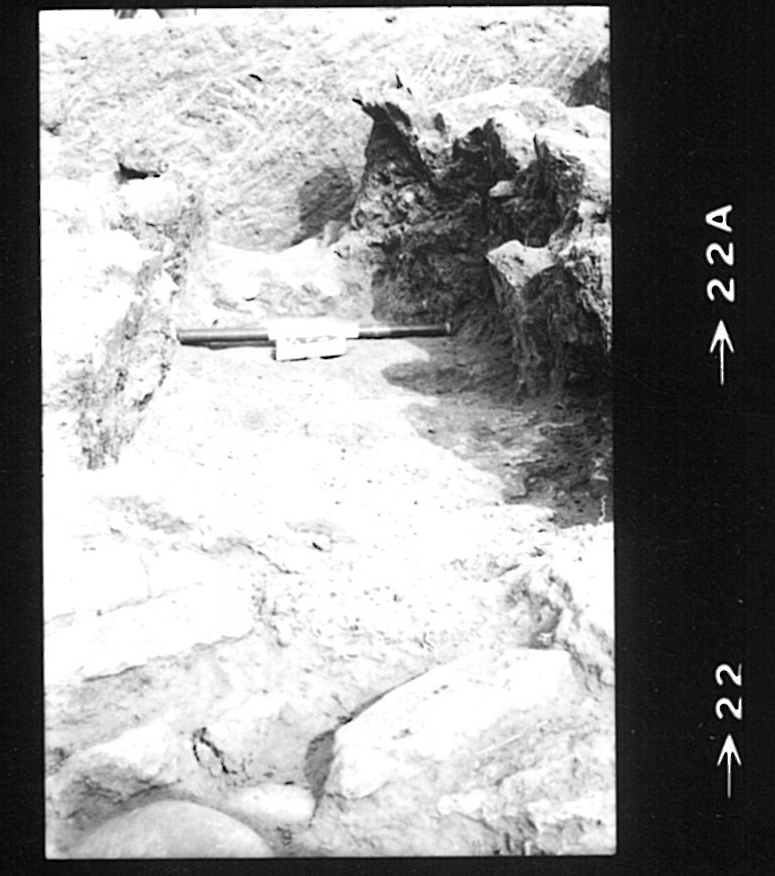
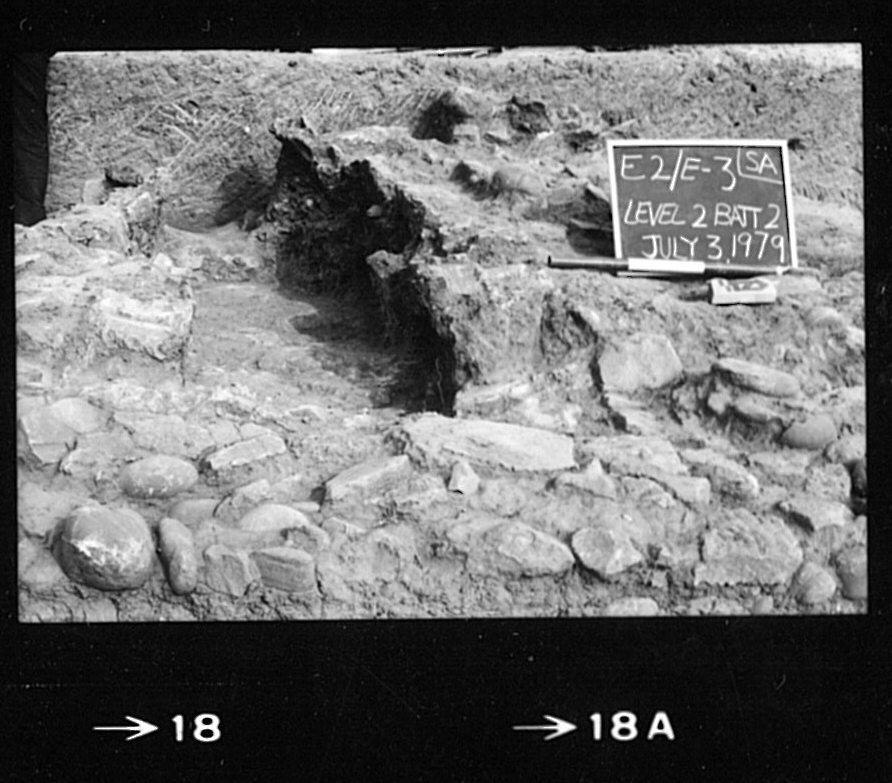
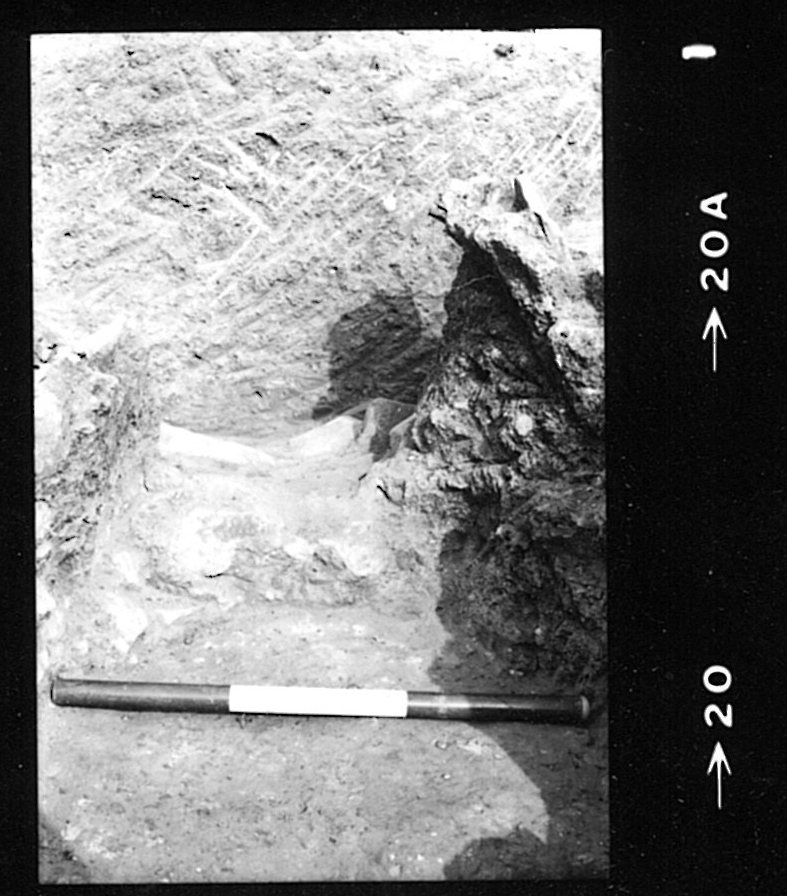
Vogliono evidentemente vedere che cosa c’è subito ad W del settore che hanno scavato, e verificare la continuazione dei muri etc. Avendo impiantato la quadrettatura si attengono ora a questo schema. Per regolarizzare la situazione asportano il topsoil subito ad W del Sounding A e della piccola fornace nei quadrati E-2 e E-3. Lasciano un baulk di 1m, che verrà in parte asportato nel 1980. Diamo a questo materiale un numero per collocarlo più facilmente nello spazio. Sebbene non sia scritto nel diario, è evidente che si tratta di E-2/E-3, triangular cut, Level 1 Batt 1. Infatti proseguono poi in E-2 con la Battuta 2.
E-2/E-3, triangular cut Row E, between Row F and previously excavated slope (=US 124; p. 105)
This procedure aims to integrate the grid area with the slope area, leaving a 1 m balk between them, parallel to the slope axis (see sketch below).
Square E-2
Finds: 2 tile frags with sunburst stamp (SA 79 764T and SA 79 936T). Also a sample of tiles (SA 79 766T), some are very pink, other very white (incrustations?) similar to those observed in adjacent F-2 where we suspect kilns are. There were both curved and thick pan tiles.
Square E-3
No stamps, but otherwise identical to E-2.
La parte superiore del KC, in F2 e F-3 era già stata indagata a partire dal 21 giugno 1979, quindi sapevano già che le due parti erano in connessione. Se 124 va definito Lev 1 Batt 1 come penso, si spiega perché la prossima è la battuta 2. In E-2 incontrano il margine E della South Kiln. A questa battuta non sono collegati materiali.
E-2, Level 1, Batt. 2 (=US 125; p. 105)
This battuta defined the rock and tile concentration which clearly is part of the kilns found in F-2. There seem to be more stone /rock between the TC walls at this (east) end than in the F-2 part.
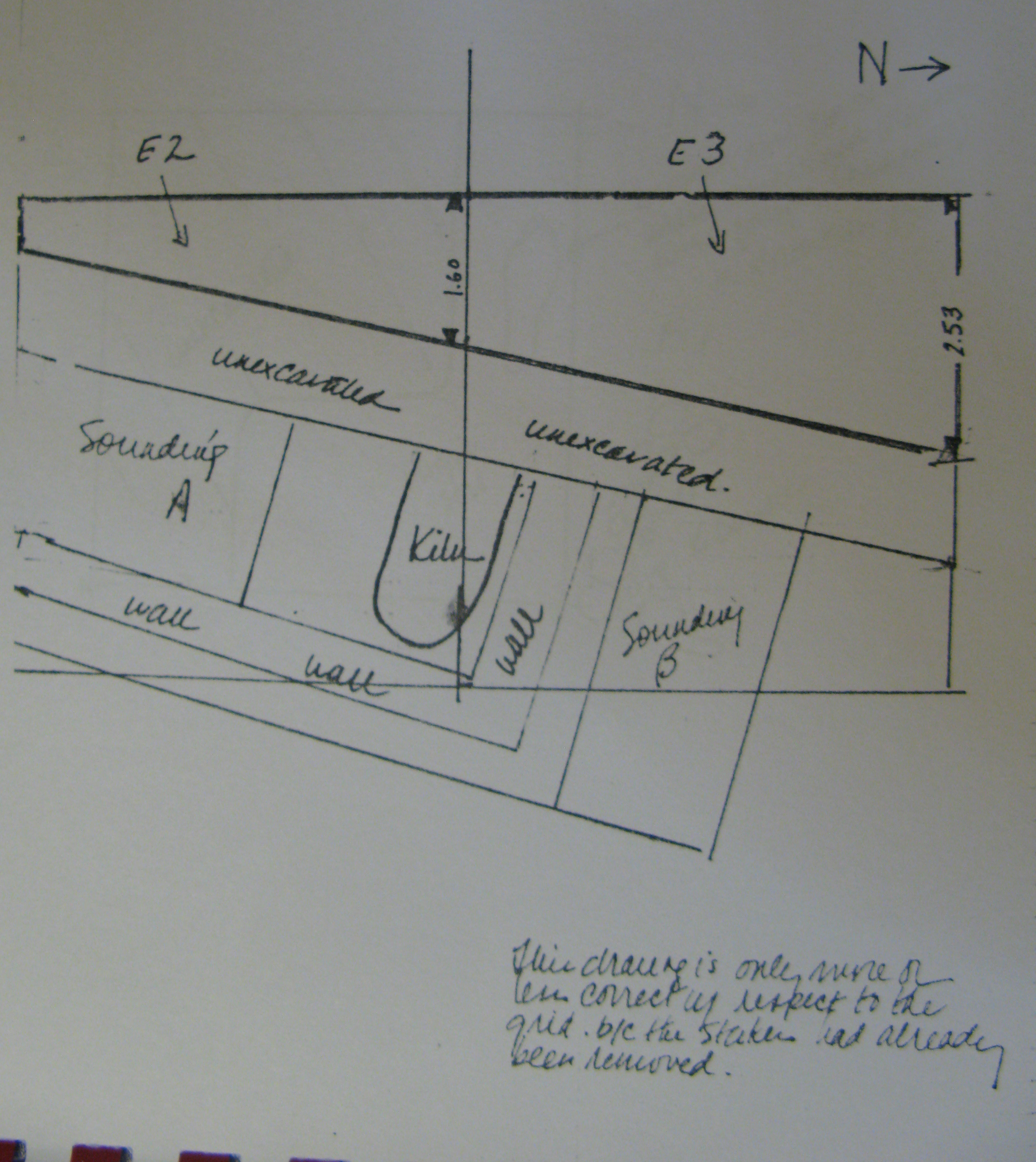
This drawing is only more or less correct with respect to the grid because the stakes had already been removed.
Summary (p. 107)
Today we finished cleaning out the E-2/E-3 kiln and then cleaned some new area near the two kiln outlines, i.e., 1) F-1, to the south of them which yielded no more information, and 2) the E2/E3 area west of the New Balk which showed us that the kilns extended further east. Also further work in G-6 continues to prove interesting, so more work will be needed here.

